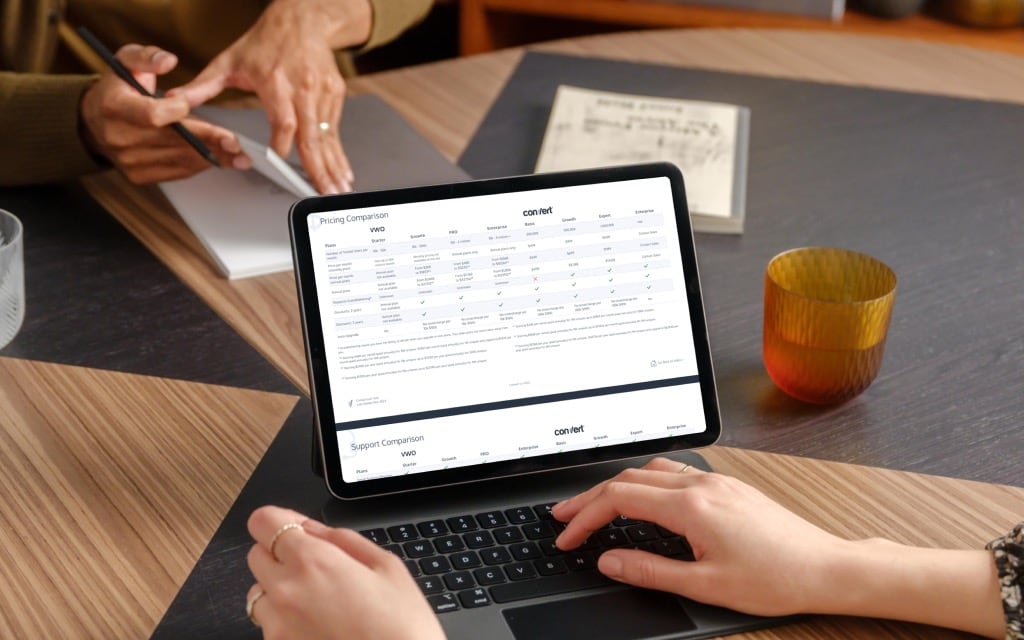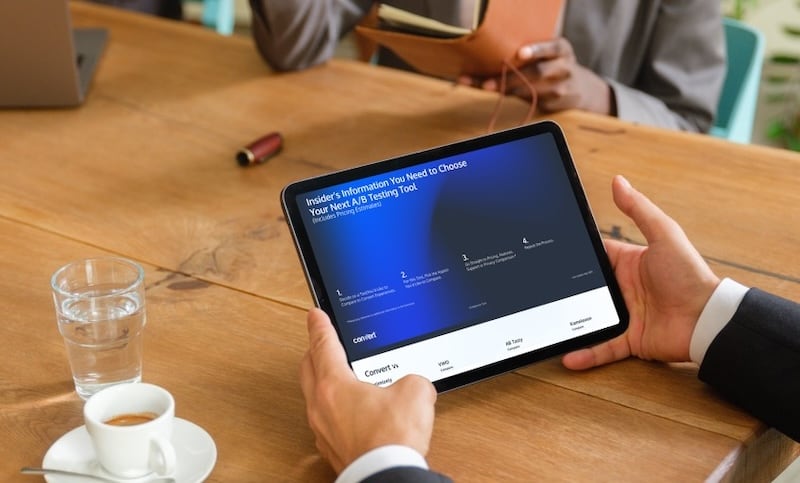Save Dozens of Hours You’d Spend Comparing A/B Testing Tools.
Easy to navigate Figma table with detailed features breakdown and price points for Convert Experiences, Optimizely, VWO, AB Tasty, Kameleoon, and Qubit.

Easy to navigate Figma table with detailed features breakdown and price points for Convert Experiences, Optimizely, VWO, AB Tasty, Kameleoon, and Qubit.

On the hunt for the best-fit A/B testing solution?
You’re at the right place.
We hope you’ve built a diverse & relevant tools consideration set using recommendations from fellow optimizers, your favorite influencers, and your community haunts.
This easy to navigate Figma table allows you to understand how the tools in your consideration set stack up against each other.
Covers admin, advanced experimentation features, analysis and reporting, security, privacy and more.
We’ve standardized how features are referred to across vendors. And also included pricing data where available.
PS: Download comes with just the Figma table. No unsolicited emails or phone calls!
We have broken up the comparison table into individual comparison charts that are detailed and thorough, yet easy on the eyes.
While we can’t really reveal competitor pricing, we give you benchmarks for many of the key players that may help you anticipate how much you’ll spend with a particular tool option.
Dennis is a vocal proponent of privacy in testing and a community builder who loves bringing knowledge from different sources to Convert’s tribe.
FAQ
Businesses use A/B testing tools to implement A/B tests, split tests, multivariate tests, and full-funnel tests. The aim is to incrementally improve the performance of online assets by eliminating issues that keep traffic from converting (or taking the desired action).
Over the years A/B testing has gone from a nice-to-have that large enterprises invest in once they have exhausted all other marketing and growth channels, to a mainstay of small, agile teams that mitigate risks associated with unvalidated web design, copy, and even operational changes through intelligent testing.
Currently A/B testing tools are a way to eliminate the dreaded HiPPO (Highest Paid Person’s Opinion).
Done right, their results speak from a place of scientific rigour and hard facts. It is difficult to argue against a large sample size of ideal customers and their projected behavior simply because of intangibles like gut instinct and “experience”.
Most A/B testing tools are client-side. They require the user to place a snippet of JavaScript code on the online assets they want to experiment on. The calculations are done back-end and a winner is declared based on chosen significance and power settings.
Some A/B testing tools like – Convert Experiences – also give users the option to further “validate” these winners as a personalization by attempting to replicate the lifts seen during the experiment without hard coding the changes right away.
Yes, free A/B testing tools do exist.
While enterprise solutions can charge more than 100k USD annually, there are solutions like Google Optimize, Nelio, and Vanity that allow experimenters to find their feet and flex their testing muscles for free.
But there is no such thing as free lunch. If you wish to scale your testing program, and eliminate common issues that plague most A/B testing drives – like the dreaded Flicker of Original Content (FOOC) and slow, unresponsive support, you will need to opt for a paid tool.
We’ve written extensively about free A/B testing tools.
An A/B testing open source software solution is one that allows you – the optimizer – to be in complete control of the code that serves variations to traffic, collects results, and creates the reports.
You have the privilege of owning the experiments you hypothesize and the customer data you collect, across all the channels you wish to improve conversions for.
Most A/B testing software open source solutions lead with the promise of better security, more customizations, ease of deployment, and a robust API that delights developers looking to dig deeper into a platform and amp up its capabilities.
The most talked about open source A/B testing tools include – ABBA, SIXPACK, PROCTOR and WASABI.
You can also read our piece on open source A/B testing tools and what to do when you outgrow them.
So how do you perform an A/B test?
An A/B test costs you. Let’s be upfront about it.
But there are ways to ensure that these issues do not derail your A/B testing program. And they have to be accounted for during test ideation and set-up.
We have created a checklist that lets you QA your experiment for 30+ critical factors. Get a free copy.
YES. The answer is an emphatic yes.
If you are committed to an experimentation mindset.
According to Convert’s research, only 1 in 5 tests is conclusive. The rest don’t even reach a conclusion. Out of that 20%, some win and some lose.
So the proportion of winning tests is probably 1 in 10.
But each test teaches you something about what not to do. It can not only protect you from misguided decisions that are based on organizational power dynamics and peer pressure, it can also, over time, build your judgment and train you to identify big lift opportunities with greater alacrity. Mind you, we are not talking about opinions. We are talking about the maturity to interpret data better.
Most importantly, even tiny lifts accumulate over time to deliver large returns.
The ROI of a single A/B test may not be persuasive, but the ROI of an A/B testing program undertaken with diligence is exponential.
A/B testing is the flavor of the season.
Almost all aspects of Digital Marketing, from landing pages to ads to emails can benefit from it and solution providers have managed to incorporate basic A/B testing in their tools.
Email marketing vendors allow users to test out different subject lines, body copy, and links for metrics like open rate and click through rate. Most even stop sending the “losing” variant once it’s been identified.
Landing page apps like Unbounce also come with A/B testing that is undertaken for a key conversion action – like a form submission.
Even third party advertising platforms like Facebook and LinkedIn encourage testing.
While it’s good to keep in mind that the version you are launching with is likely not your best work, it also pays to remember that one against the other type scenarios are not robust A/B testing.
Sample sizes aren’t calculated for the desired Minimum Detectable Effect (MDE), significance and power settings are not specified, and there are no rules to prevent premature peeking.
Want to learn more about the statistics behind A/B testing? Try our free statistical significance calculator.

